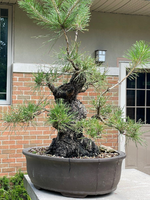I'm trying to understand what is possible in terms of trunk development employing just sacrifice branches (I understand that both trunk chop and sacrifice branch techniques are typically used in tandem, but I am trying to understand the growth put on from sacrifice branches). For example, I have come across pre-bonsai whose trunks I like - They need to thicken up and add taper, but the structure/movement of the trunk is already acceptable. Assuming the entire length of the trunk is approximately the same thickness (i.e., little to no taper), how much taper can reasonably be expected over time using sacrifice branches? Stated differently, one can achieve great taper (in addition to movement) by the cut and grow method. Can the same taper be accomplished with sacrifice branches (ignoring movement which the trunk already has)?
You are using an out of date browser. It may not display this or other websites correctly.
You should upgrade or use an alternative browser.
You should upgrade or use an alternative browser.
Trunk Development - Chops vs. Sacrifice Branches
- Thread starter dbonsaiw
- Start date
JesusFreak
Shohin
I think it all depends where the sacrificial branch is.
The assumption is that we are growing sacrifice branches in the places we want to thicken the trunk, so I don't understand your comment. The question is whether one can develop the same type of taper using just sacrifice branches as one can from cutting and growing.I think it all depends where the sacrificial branch is.
Are you answering the question in the affirmative, provided the sacrifice branches are growing in the right places?
To move the convo along, the bonsai I admire most appear to have been developed using a cut and grow method to develop the taper. I assume that's because cut and grow does a better job at creating taper. Thus my question - what kind of taper can be accomplished with sacrifice branches?
Gustavo Martins
Omono
If you let the sacrifice branch grow the trunk will fatten in direct proportion to length of the sacrifice branch. Just imagine the extreme scenario where you forget to trim the sacrificial branch during a long period of time. The tree will continue to grow as if the sacrificial branch was the main trunk.
The thing is. It’s usually a compromise between trunk thickening and the size of the scar left when tou cut the sacrificial branch.
Hope that helps.
The thing is. It’s usually a compromise between trunk thickening and the size of the scar left when tou cut the sacrificial branch.
Hope that helps.
Dav4
Drop Branch Murphy
- Messages
- 13,948
- Reaction score
- 34,907
- USDA Zone
- 6a
BrightsideB
Omono
The ones coming straight out of the nebari will ad more to the size to it once it’s cut flush leaving your main trunk still in tact. It’s essentially growing a twin trunk but one is a sacrificial trunk/branch.
Srt8madness
Omono
A sacrifice will thicken what is underneath it. So you can have multiple sacrifice branches. It just so happens that the leader is often a sacrifice as well.
Cajunrider
Imperial Masterpiece
Yep. Afterall, what we call the chop is nothing but cutting off the sacrifice top.A sacrifice will thicken what is underneath it. So you can have multiple sacrifice branches. It just so happens that the leader is often a sacrifice as well.
River's Edge
Imperial Masterpiece
The response from which is a very important aid to further development if timed appropriately!what we call the chop is nothing but cutting off the sacrifice top
I Just mention this so others will recognize the developmental value in chopping the leader aside from using it to thicken the trunk.
Often the new growth becomes the lower primary branches needed for final design of smaller trees, once the trunk is developed. Can save a lot of grafting.
Shibui
Imperial Masterpiece
Theoretically you should be able to achieve great taper with sacrifice branches but there's a couple of problems you may encounter.Can the same taper be accomplished with sacrifice branches (ignoring movement which the trunk already has)?
@Gustavo Martins has already mentioned the problem of scars left after removing sacrifice branches.
Larger sacrifice branches leave larger wounds when they are finally removed. Try to develop sacrifice branches at the rear of proposed trunk line if you don't want to make a feature of the chop.
Multiple sacrifice branches will give faster thickening but will also leave more scars. Scars all round the trunk can limit sap movement from roots to upper trunk. At extremes removing many large sacrifice branches can severely affect tree health.
After a trunk chop we usually still allow lots of growth to develop a new trunk and apex. That growth helps to heal the chop.
After removing sacrifice branches there may be no need to allow lots of growth in which case cuts take a long time to heal.
This problem can be overcome by using the sacrifice branches of the cuts made as dead wood features so they don't need to heal over.
Thickening of a trunk tends to straighten the trunk. Sap takes the shortest path between roots and leaves and trunks thicken quicker where sap flow is highest. That turns out to be inside bends so trunks thicken much more inside of bends and less outside bends resulting over time in straightening of the trunk. If any sacrifice branches are above bends in the trunk those bends may slowly disappear as the trunk increases girth.
Similar threads
- Replies
- 3
- Views
- 496
- Replies
- 9
- Views
- 2K
- Replies
- 7
- Views
- 1K
- Replies
- 4
- Views
- 969



